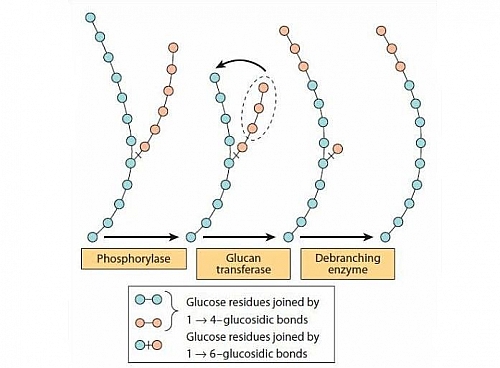Glycogenolysis is the breakdown of glycogen to glucose with the help of an enzyme known as Phosphorylase enzyme. Glycogenolysis occurs in the liver and muscles and the enzyme responsible for this process is found in both the liver and muscles.
Table of Contents
Glycogenolysis Definition
Glycogenolysis can be defined as the breakdown of glycogen to produce glucose by Phosphorylase enzyme which can be found in the liver or muscles.
What is Glycogenolysis?
Glycogenolysis means the breakdown of the stored glycogen of a cell to re-form glucose for use to provide energy. Glycogenolysis is not a reversal of Glycogenesis (formation of glycogen) because each succeeding glucose molecule on each branch of the glycogen polymer is split away by phosphorylation, catalyzed by the enzyme phosphorylase. Under resting conditions, the phosphorylase enzyme is in an inactive form so as to allow for the storage of glycogen. When it becomes necessary to re-form glucose from glycogen, the phosphorylase is then activated by some hormones in the body such as the release of epinephrine (adrenaline) or glucagon.
Glycogenolysis Meaning
Glycogenolysis is the process of breaking down glycogen into glucose molecules through the delinking of single glucose molecules from glycogen by the enzyme phosphorylase this enzyme breaks the 1:4 linkages while another enzyme (the debranching enzyme) breaks the 1:6 linkages. The bonds or linkages of the glycogen are usually phosphorylated before they are broken to glucose-6-phosphate – in the liver, glucose-6-phosphate is dephosphorylated to glucose and released in blood while in the muscle, the glucose-6-phosphate produced is consumed by the muscle itself through glycolysis.
Glycogenolysis Pathway
Understanding Glycogenolysis pathway is simple when you know that Glycogen is a highly branched compound made up of glucose residues (many glucose branches joined together to form a larger compound). Therefore glycogen breakdown will require breaking debranching the glucose residues. There is an enzyme responsible for debranching glycogen and it is called the Debranching enzyme (Glucan transferase).
The glycogen branches are attached through bonds (links). These links are called alpha glucosidic bonds. The links are named according to the carbon number (carbon position in the glucose residue) hence -(1,4) glucosidic bond means that C1 of one glucose residue is joined to C4 of another glucose residue by alpha glucosidic bonds; while -(1,6)-glucosidic bond means that C1 of one glucose is joined to C6 of another glucose residue by alpha bonds.
Each enzyme of glycogenolysis has its use and ability to break a specific type of bond. Phosphorylase enzyme can only break alpha 1,4 glucosidic bonds while Glucosidase enzyme can only break alpha 1,6 glucosidic bonds.
Glycogenolysis Steps
- Step 1: Phosphorylase step this is the first step of Glycogenolysis and it is the rate-limiting step. The phosphorylase enzyme is the rate-limiting enzyme of Glycogenolysis and also the key enzyme in glycogenolysis. The phosphorylase enzyme has active and inactive forms. The action of phosphorylase is to phosphorolytically remove single glucose residues from -(1,4)-linkages within the glycogen molecule (this reaction produces glucose 1-phosphate). The advantage of the reaction proceeding through a phosphorolytic step is that the glucose is removed from glycogen is an activated state (i.e. phosphorylated) without ATP hydrolysis. Glucose 1-phosphate produced by the action of phosphorylase is converted to glucose 6-phosphate by phosphoglucomutase enzyme. Glycogen phosphorylase cannot remove glucose residues from the branch points of -1,6 linkages in glycogen, hence another enzyme has to takeover.
- Step 2: Glucan transferase step after the activity of phosphorylase, there will be 4 glucose residues left from the branch point and another enzyme will continue the breakdown. The remaining glucose residues are removed by a debranching enzyme called Glucan transferase which can act as a glucotransferase and also as a glucosidase. The transferase activity removes 3 more glucose residues from the remaining 4 (leaving behind 1 residue which is the residue attached by alpha 1,6 glucosidic bond). The transferase activity whenever it removes a glucose residue, will attach it to a free C4 end of a second branch.
- Step 3: Glucosidase step the remaining glucose residue (which is the last of the branch) has -(1,6)-linkage at the branch this is then removed by the action of glucosidase as free glucose.
Where does glycogenolysis take place?
Hepatic Glycogenolysis (Liver Glycogenolysis)
The release of glycogen stored in the liver is triggered by low levels of glucose in the blood. Liver glycogen breakdown leads to glucose-6-phosphate which is hydrolyzed to give glucose. The release of glucose from the liver by this breakdown of glycogen replenishes the supply of glucose in the blood which is reflected by a rise in blood glucose.
Muscle Glycogenolysis
In muscles, the glucose-6-phosphatase enzyme is absent. Hence glucose-6-phosphatase enters into the glycolytic cycle and forms pyruvate and lactic acid directly rather than being hydrolyzed to glucose and then exported to the bloodstream. Muscle glycogenolysis does not contribute to blood glucose.
Regulation of Glycogenolysis
Control of glycogenolysis occurs through some hormones in the body such as Glucagon and Adrenaline which are usually released when the blood sugar level is low.

